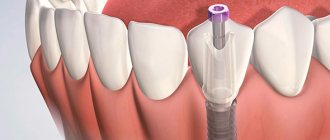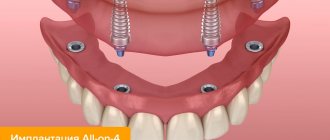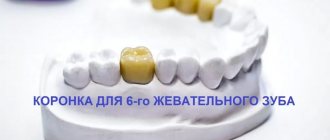Dental implantation became a real breakthrough in the field of dentistry thanks to the scientist Ingvar Brånemark. It is noteworthy that this method was discovered by chance. The professor conducted research in the field of blood supply and during the experiment implanted a titanium plate into the bone tissue of an experimental animal (rabbit), which successfully took root - this is how the process of osseointegration was discovered, which formed the basis for the successful engraftment of foreign bodies (implants) in human bone tissue1.
Prices at Doctor Zhuravlev Clinic
| Plastic crown (temporary) | PC. | 1000 rub. |
| Solid crown | PC. | 3600 rub. |
| Metal-ceramic crown | PC. | 6000 rub. |
| Metal-ceramic crown on an implant | PC. | 15,000 rub. |
| Zirconium oxide crown for implant | PC. | 16,000 rub. |
| Crown based on zirconium oxide | PC. | 13000 rub. |
| Partial removable denture | PC. | 14,000 rub. |
| Complete removable denture | PC. | 16,000 rub. |
| Nylon prosthesis for 1 jaw | PC. | 30,000 rub. |
| Nylon prosthesis with a metal base for 1 jaw | PC. | 33,000 rub. |
| Clasp prosthesis | PC. | 36,000 rub. |
| Surgery to install an Astra Tech implant (Sweden) (the cost of the implant is paid separately) | PC. | 20,000 rub. |
Many of us have had to lose permanent teeth - completely or partially. When only the visible – crown – part of the tooth is destroyed, dentists do not consider this “unit” lost, because even on the remaining root, restoration can be carried out using a core tab and a crown. But it also happens that a tooth must be removed, and then it will have to be replaced with an artificial one. Is it mandatory to insert teeth if they are not visible and their absence does not spoil the smile? Without restoration of the dentition, degradation processes may begin:
- it becomes more difficult to chew food;
- teeth, due to uneven load, may shift towards the removed root (if the root remains but the upper part of the tooth is missing, then this does not happen);
- the bone tissue of the jaw begins to gradually dissolve in the place where the tooth is missing, as it does not receive adequate load;
- facial features are distorted.
That is why, after extraction, the clinic will always offer you to insert teeth, and which ones are better is up to you and your doctor to decide. You should proceed from your financial capabilities, and the doctor should look at what method of prosthetics is indicated for you.
Features of the method
All-on-4 is a technology of simultaneous implantation and dental prosthetics, when the patient is implanted with only 4 implants, on which a conditionally removable denture is fixed. Fastening the prosthesis with screws allows the dentist to quickly and easily remove it (this may be necessary, for example, for its correction).
Indications:
- Complete absence of teeth on one or both jaws.
- Bone atrophy.
- Contraindications to traditional two-stage technology.
- Periodontal diseases.
- The previously installed bridge and crowns are worn out
Restrictions and contraindications:
- Malignant neoplasms.
- Diabetes.
- Kidney, liver and heart failure.
- Blood diseases.
- Extreme bone atrophy in the upper jaw.
- Temporary restrictions: inflammatory diseases of the nasal sinuses and infections of the oral cavity.
How to insert teeth: methods used today
Everyone is interested in which teeth are best to insert, what materials are used for this, and how long will you have to wait until the dentures or crowns are ready? More inquisitive patients ask: are wisdom teeth prosthetic? It all depends on the specific case. If, for example, you need to insert three teeth – the 5th, 6th and 7th, then the 8th tooth may well become the supporting one. But if only the wisdom tooth itself is lost, then it does not need to be replaced. If a removable prosthesis of chewing teeth is made, then, as a rule, there are no “eights” in it: this is justified, since the amount of work of the dental technician is reduced and, accordingly, the patient’s costs are reduced. The remaining teeth - canines, incisors, molars - are definitely subject to prosthetics.
There are several ways to insert teeth:
- Make a removable denture based on natural or implanted teeth.
- Replace a missing tooth with an implant.
- Place a bridge supported by an implant or natural teeth.
- Install a clasp prosthesis.
- Create a removable denture supported by soft tissue and mucous membrane with complete edentia.
There are also several materials from which crowns and artificial teeth are made. They vary significantly in cost, which allows you to choose prosthetic options for different budgets.
Stamped crowns
These are prosthetics that are made from factory sockets, which are given the desired shape. They have thin walls, so there is no need to grind off a large amount of tooth tissue. They are installed if there is no destruction of the roots and at least a third of the tooth crown is preserved.
To create them, stainless steel or gold is used.
The ease of manufacture resulted not only in low cost, but also in the short service life of the product. Gold stamped crowns are made from an alloy that is 90% gold. For the chewing surface, gold of a lower standard is used to increase its resistance to mechanical stress.
Manufacturing stages:
- The patient takes impressions of both jaws to model the crown, which must be done over the next 15 minutes until shrinkage of the material begins.
- The boundaries of the prosthesis are marked on the plaster so that it does not turn out to be too narrow or wide.
- Modeling with wax. Wax is applied to the surface of the plaster to give the crown an anatomical shape.
- Based on the cut out model, a metal stamp is made, which is hammered into the sleeve.
- External stamping is carried out using a screw press.
- The die is removed and the edges are trimmed with crown scissors.
During manufacturing, firing is carried out several times to make the metal more dense and unyielding. The prosthesis should not have cracks or irregularities.
Indications for installation of a stamped crown
Stamped crowns are installed:
- For temporary prosthetics of a baby tooth before replacing it with a permanent one.
- As a supporting element when installing a bridge prosthesis.
- When a tooth is damaged by caries or injured so much that it cannot be restored with a filling.
- To protect a healthy tooth if a clasp denture is installed on it.
Is it expensive to get teeth inserted?
Unfortunately, if you expect to receive the services of an orthopedic dentist under your insurance policy, then you will not be able to do this. Of course, if you belong to preferential categories of citizens, then you can use such medical care for free or receive substantial compensation. In other cases, you can only count on a tax deduction. Therefore, there is no big difference whether you go to a private or public dental clinic. Sometimes even commercial medical institutions hold promotions that will make prosthetics cheaper for you.
Choosing where to get treatment
You can choose a dental clinic based on price level, but you just need to make sure that they can help you there. Sometimes it happens that someone’s teeth were inserted poorly, after which complications arose or the result turned out to be unaesthetic. Typically, such patients leave unflattering reviews about a medical institution or a specific doctor. They also write where they went next, and where they managed to fix everything. However, you should not completely rely on these reviews. After all, if a person writes and does not know what kind of doctor he is who inserts teeth, what his specialty is called, then is it worth trusting such assessments? Anyone who actually underwent treatment knows for sure that he consulted an orthopedist or orthodontist, that the prosthesis was made by a dental technician - and this is a different specialist, and that the preparatory work was done by a dental therapist. In small clinics, a doctor can combine the work of an orthopedist and a therapist, but never also act as a dental technician!
So it’s always better to rely on the choice of your friends rather than on the opinion of a stranger who left a review on the site. Such a person could be hired by competitors to ruin the reputation of the dental clinic.
Content
- Veneers
- Advantages of veneers
- White teeth as a result of whitening
- Benefits of in-office whitening
- Braces
- What is better to choose - braces or veneers?
The concept of beautiful teeth presupposes the correct bite and the relationship between the size of the teeth, their shape, shine and color. The Hollywood smile does not go unnoticed - it encourages communication, and malocclusions become a source of discomfort - both moral and physical. Various techniques have been created to eliminate problems. What actions can be taken to make beautiful teeth if you are not happy with their appearance?
Studying price lists
After choosing a clinic, you need to understand how much it costs to insert a tooth, what are the prices per “unit” for a particular method. The cheapest option would be a removable plastic prosthesis, the most expensive would be an implant. If you need to insert a tooth using this method, the price may be quite reasonable, but if you need to insert the teeth completely, then it is better to use the “all on 4” method. In this case, only four implants are installed, onto which the entire jaw structure is attached. This not only makes the procedure cheaper, but also reduces time costs.
If you need to replace several teeth, you can use clasp or bridge structures. They are much cheaper than implants, but they will not protect you completely from loss of bone tissue.
What teeth can be inserted to make them look like real ones?
Today, dentists have practically abandoned metal crowns and dentures in the visible part of the dentition. Among the materials from which dental crowns and dentures are made are zirconium dioxide, ceramics, metal ceramics, and plastic. Ceramic and zirconium dentures are most similar to real teeth, but they are expensive. Plus, porcelain (ceramics) does not have the proper strength for a chewing tooth. Typically, those artificial teeth that bear high loads are made of metal ceramics, metal or zirconium dioxide. Metal is used where teeth are not visible in the smile area, and the patient should not be allergic to this material. Zirconium crowns are expensive and therefore not available to everyone. That is why metal ceramics are the most common at the moment. It has one drawback: the necks of the teeth have a metal strip, which can be noticeable, especially if it oxidizes. Overall, this material is durable and aesthetically pleasing. So, if you have a relatively small budget, it’s worth choosing it.
If you have very little money, then which teeth are best to insert so that the prices do not seem exorbitant? In this situation, you can count on temporary plastic prostheses. They can be made either as removable ones, or as full-fledged crowns on stump inlays or a bridge. The service life of plastic is short, but while wearing such prostheses you can save up for a better option. This is especially true when you need to completely insert teeth.
Types of metal crowns
If you contact a specialist to install a metal crown, you will be offered two options depending on the method of its manufacture:
- Stamped. A standard sleeve, which is processed with a special apparatus to give it the desired shape.
- Solid cast. It is made from individual casts by firing in a kiln. It has thicker walls, which has a positive effect on service life.
They are made from noble (gold, palladium, silver, platinum) and base metals (steel, nickel and chromium alloys). Because of their metallic color, they are used only for prosthetic teeth on the side teeth, which are not visible when speaking. Ideal for prosthetics of chewing teeth, as they can withstand heavy loads.
How long does it take to insert teeth?
Is it possible to get teeth inserted in one day so that you don’t have the reputation of a gap-toothed person? If you use modern methods of inserting teeth, you can get quick results. However, a lot depends on the condition of your oral cavity. She needs to be prepared for prosthetics. It is this stage that most often takes a lot of time. Before you insert teeth, they need to be made, and this takes time, because the prosthesis is made individually, based on a cast of your jaw.
Inserting temporary teeth in one visit is quite possible. At least you will not remain toothless for the period while your permanent denture is being made. If the task is not to replace the removed “unit”, but only to insert 1 tooth that is badly damaged, then you will have to visit the dental office several times. For example, you will have a ceramic tooth inserted, but before that:
- heal the root;
- the remains of the coronal part will be removed;
- they will take an impression of the stump inlay;
- they will make it;
- will install;
- the impression will be taken again;
- a crown will be made;
- will carry out a fitting;
- They will install a crown or return it to the dental technician for revision.
Here is the answer to the question: how many days does it take to insert teeth? From one day to several weeks, if we are talking about restoring a tooth from which a strong root remains. But how then are teeth inserted if there is no root? If bridge prosthetics is performed, then you can limit yourself to one impression, but it is unlikely that you will be able to insert teeth without turning the supporting “units”. And preparing teeth also takes time. So in this situation, one visit is not enough.
Today, more and more often there are proposals to insert teeth in one day and even put an immediate load on the implant, whereas previously it was believed that this titanium element must still take root in the human bone tissue before an abutment and crown are installed on it. And this sometimes took several months. What may have changed in technology to allow immediate loading of implants is worth exploring in more detail.
When a front tooth cannot be saved
After a serious fracture, when the roots of the unit are destroyed due to caries, a protracted destructive process, immediate removal of the unit is required. Many are afraid of being left without a front tooth, but the clinic’s dentists remind: most patients are suitable for immediate implantation.
This is a way to extract and insert a tooth in one session: only one anesthesia is needed, two operations are combined into one. The price depends on the type of implant and related factors.
The tooth is removed and the implant rod is placed in the same hole, the gum is sutured. Many patients are indicated for immediate weight bearing. A temporary plastic crown is placed on the pin, replacing it after complete healing with a permanent model. In one visit you will lose your damaged tooth and acquire a new functional artificial root. The technique allows you to quickly return the tooth and not get upset when looking in the mirror.
Our clinics provide only high-quality care: we value your health and care about our own reputation. There is no point in saving on the main thing - we offer treatment in installments. We restore the smile area today, and the patient can take advantage of interest-free installments, paying for the treatment in installments.
How to insert a dental implant
Indeed, it can take six months for an implant to heal. But if prosthetics are done in the smile area, then the patient is given a temporary orthopedic structure that covers the defect. It turns out that the proposal to insert teeth in one day actually means eliminating an aesthetic problem rather than returning a person to the ability to chew food as before.
To be fair, it is worth noting that the installation of the implant is done in one visit. This operation is performed under local anesthesia, so the question of whether it is painful to insert a dental implant is unnecessary. How long does it take to insert teeth if you need to replace several lost units in a row? It is better to install implants right away, so as not to drag out the prosthetic process for a long time. However, if the patient has already had an implant installed, but then there is a need for prosthetics for another tooth, then each of these units can be treated separately. It all depends on the specific case.
Modeling a solid crown
A more durable prosthetic option is to install a solid crown made of cobalt-chrome alloy. As the name implies, they are cast completely, and not in parts, like stamped ones. An undeniable advantage of a cast crown is the absence of solder joints, which makes it especially durable. It fits tightly to the ground tooth, preventing the cement from dissolving and reducing the risk of food getting under it. Wearing period is 15-20 years.
Modeling a solid crown includes several stages:
- Tooth preparation. From 0.3 to 0.5 mm of tissue is sanded off.
- Making impressions, including adjacent and opposing teeth.
- Creating a wax cap using the stretching method.
- Casting the prosthesis.
- Metal surface treatment. Fitting, finishing, polishing.
Types of solid crown
Nowadays, several types of solid crowns are installed in the dentist’s office:
- Without spraying, these are ordinary crowns of a metallic color.
- Sprayed. If the patient is not satisfied with the low level of aesthetics, at his request, the crowns can be coated with a coating that imitates gold.
- With lining. Crowns lined with ceramics are even more aesthetically pleasing. Their front part is covered with a ceramic lining. If you have just such a prosthesis installed, be careful when eating, as ceramics tend to chip.
- Combined. With combined prosthetics, some of the crowns are veneered with ceramics, and the rest, which are not visible when smiling, are installed without veneering.
How long does it take to insert teeth after extraction?
Usually the doctor lets the hole heal and only then takes on prosthetics. After all, it is not always possible to insert a tooth in place of a removed one right away. An exception may be new technologies that allow an implant to be installed directly into the hole. But we are talking only about it, and not about the complete structure. Often such operations are performed under general anesthesia. Teeth can be inserted under anesthesia for those patients who are afraid of the dental office, even if there are no other indications other than psychological ones.
Does it hurt to put teeth in?
It is impossible to say that it is possible to insert ceramic teeth so that the patient does not experience discomfort at any stage. Any prosthesis cannot be made perfectly right away, so it must be adjusted. And if a chewing tooth is inserted incorrectly, it can touch soft tissue when a person chews or even talks. Sometimes even a patient can come and start complaining that after he had a tooth inserted, it hurts. On the one hand, this may seem funny, since an artificial structure cannot hurt on its own. On the other hand, this is a reason to pay attention to the condition of soft tissues, because they are the ones that can hurt and become inflamed. If the prosthesis is made on an inlay, that is, with a real tooth root, then there may be options for the development of periostitis and other inflammatory processes. It is enough for the infection to get into the canal at the root, and the body may not be able to cope with it on its own.
Not only a ceramic tooth can be inserted unsuccessfully, but also a plastic or metal-ceramic one. If possible, the doctor should adjust such a prosthesis on the day of installation so that the patient does not experience pain. The most difficult thing is with removable dentures, as they require long-term correction. Initially, the installation of this orthopedic structure does not cause discomfort, but it may appear later, when the patient has already left the office.
Such dentures rub the gums, so they have to be ground down, and it is not always possible to identify all the problem areas the first time, so that a person feels with the removable structure as with his own teeth. But this is a good way to insert teeth on a limited budget.
Damage to a metal crown
In some cases, a metal crown can cause harm:
- After its installation, galvanic syndrome may develop. This is caused by the use of several alloys to make the orthopedic structure. The combination of differently charged metals leads to the generation of galvanic current. A metallic taste, swelling and burning in the mouth, headaches, sleep disturbances, and malaise appear.
- A stamped crown is not made from individual impressions, so it is not suitable for fully recreating the functions of a living tooth.
- It does not fit tightly to the tooth, forming a gap between the walls into which food debris gets trapped. Therefore, healthy tissue can begin to rot underneath it.
- A one-piece prosthesis has high thermal conductivity. Therefore, if it was installed on a non-pulpless tooth, unpleasant sensations may occur when eating hot food.
Where can I get quality teeth inserted?
If you need prosthetics, it is better to choose a clinic where they do it efficiently. If you don’t have someone who can recommend a doctor or medical institution, then you should go to the website of the clinic that interests you. If it describes in detail how, for example, to insert teeth made of zirconium or metal-ceramics, then this is already a plus. If there is information about specialists, photographs of dentists and dental technicians, then this inspires even more confidence, and when there are one or several pages with certificates - both of the organization and of the doctors - this is the best option. If you still doubt that this is a clinic where they can insert high-quality teeth, then you can call and make an appointment with a doctor. This way you will form an impression of the doctor and understand whether you can be treated by him. After all, personal contact between the doctor and the patient also decides a lot.











